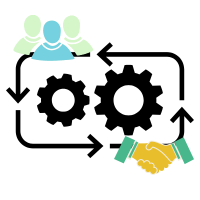Process Automation
Process automation is like having a team of tireless digital assistants working around the clock. Just as a well-organized factory uses machines to handle repetitive tasks, automation tools help streamline operations, reduce errors, and free up human resources for more complex work. Whether you’re automating deployment pipelines or routine maintenance tasks, understanding automation is crucial for modern operations.
The Impact of Automation
1. Efficiency
- Reduced manual effort
- Faster execution
- Consistent results
- 24/7 operation
2. Reliability
- Error reduction
- Standardized processes
- Audit trails
- Quality assurance
3. Scalability
- Handle increased workload
- Rapid deployment
- Resource optimization
- Cost reduction
Core Concepts
1. Scripting
Think of scripting like teaching a robot to perform tasks:
- Shell scripts are like basic instructions
- Python scripts are like complex programs
- Configuration files are like rulebooks
#!/bin/bash
# Example deployment script
echo "Starting deployment..."
git pull origin main
npm install
npm run build
pm2 restart app
echo "Deployment complete!"
2. Workflow Automation
Workflow automation is like setting up an assembly line:
# Example GitHub Actions workflow
name: CI/CD Pipeline
on:
push:
branches: [ main ]
jobs:
build:
runs-on: ubuntu-latest
steps:
- uses: actions/checkout@v2
- name: Install dependencies
run: npm install
- name: Run tests
run: npm test
- name: Deploy
run: |
npm run build
aws s3 sync dist/ s3://my-bucket/
3. Infrastructure as Code
Infrastructure as Code is like having a blueprint for your digital infrastructure:
# Example Terraform configuration
resource "aws_instance" "web" {
ami = "ami-0c55b159cbfafe1f0"
instance_type = "t2.micro"
tags = {
Name = "WebServer"
}
}
resource "aws_security_group" "web" {
name = "web-sg"
ingress {
from_port = 80
to_port = 80
protocol = "tcp"
cidr_blocks = ["0.0.0.0/0"]
}
}
Modern Automation Practices
1. Development
- Continuous Integration
- Automated testing
- Code quality checks
- Dependency management
2. Operations
- Configuration management
- Monitoring automation
- Backup automation
- Security scanning
3. Deployment
- Continuous Deployment
- Infrastructure provisioning
- Environment management
- Rollback procedures
Best Practices
-
Planning
- Document processes
- Identify automation candidates
- Set success criteria
- Plan for failure
-
Implementation
- Start small
- Use version control
- Test thoroughly
- Monitor results
-
Maintenance
- Regular reviews
- Update documentation
- Monitor performance
- Handle exceptions
-
Security
- Principle of least privilege
- Secure credentials
- Audit logs
- Regular security reviews
Project Structure
automation/
├── scripts/
│ ├── deploy.sh
│ ├── backup.sh
│ └── monitor.sh
├── workflows/
│ ├── ci.yml
│ └── cd.yml
├── terraform/
│ ├── main.tf
│ └── variables.tf
├── docs/
│ └── automation-policy.md
└── README.md
Next Steps
Resources
Need Help?
If you need assistance with process automation, contact our support team for expert guidance.
